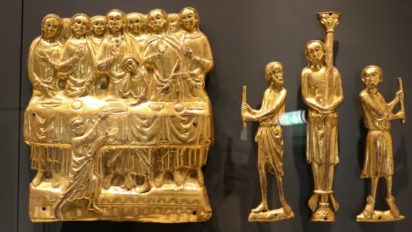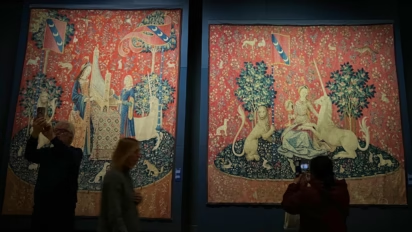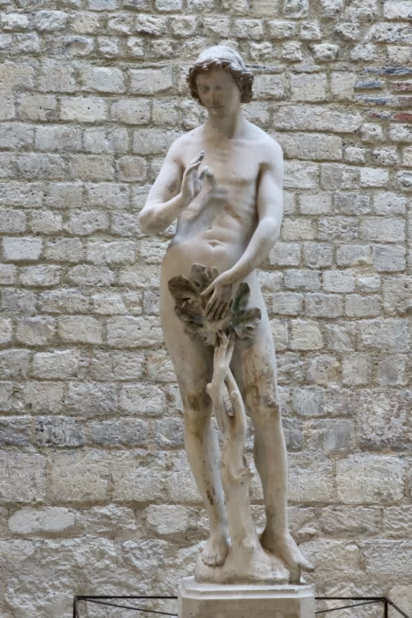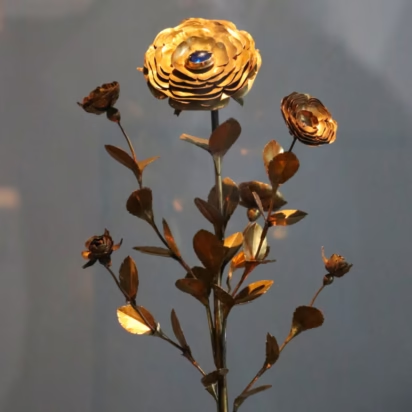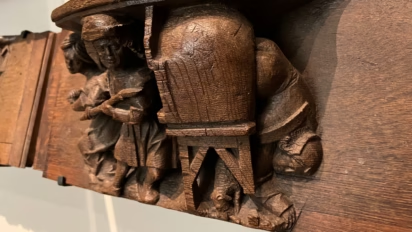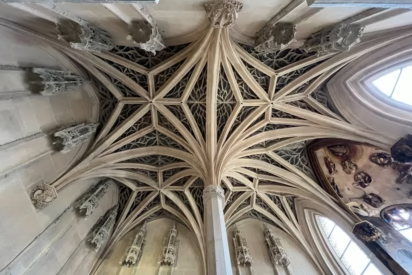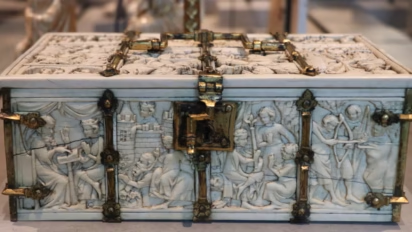Visit the wonderful Musée de Cluny French National Museum of the Middle Ages in Paris to see medieval history and art, including The Lady and the Unicorn tapestry series.

The Cluny Museum National Museum of the Middle Ages (Musée de Cluny-Musée National du Moyen Âge) is one of the finest museums in Paris and home to one of the world’s largest collections of medieval art. It is most famous for its magnificent collection of medieval tapestries including the amazing The Lady and the Unicorn tapestry series. The rest of the exhibition includes artworks, implements, and religious paraphernalia typical for a major European museum of the Middle Ages. The best times to visit to avoid school groups are around lunchtime or late afternoons. The Paris Museum Pass is valid.
Musée de Cluny-Musée National du Moyen Âge
The (Musée de Cluny-Musée National du Moyen Âg is located inside the remains of a large Gallo-Roman bath complex, the medieval Hôtel de Cluny (the Parisian palace of the Abbot of Cluny), and a modern wing.
Although the collection consists of over 23,000 items, only around 2,000 are permanently displayed. These are spread over two dozen not very large rooms making the museum easy to visit. History buffs and art lovers could easily spend half a day here but many visitors are in and out in less than an hour to see the highlights.
The absolute highlights of the Cluny Museum include The Lady and the Unicorn tapestry series, the Roman frigidarium, early medieval sculptures, stained-glass windows, and intricately worked decorative art objects.
Visiting the Cluny Museum of the Middle Ages in Paris
Compared to the Louvre, Orsay, or Pompidou, the Cluny Museum is not only much smaller but much easier to visit with a simple layout spread over two floors. The displays are roughly chronologically and then divided into themes. It is sensible to follow the room numbers but there is no prescribed route or one-way system.
The earliest works in the collection from antiquity and the early Middle Ages (c. 1st to 11th centuries) are in the well-preserved frigidarium of the original Gallo-Roman baths down a flight of stairs from the museum entrance. The rest of the ground floor covers the High Middle Ages (11th to 13th centuries).
The halls on the upper level are used for the Late Middle Ages (14th and 15th centuries) and temporary exhibitions. The Lady and the Unicorn tapestries are in room 20, the second last hall of the permanent exhibition.
The Lady and the Unicorn Tapestry

The Lady and the Unicorn (La Dame à la licorne)– a cycle of six wall-hanging tapestries — is the most famous object in the Cluny Museum and a jewel of medieval European art. These large tapestries in the mille-fleurs (thousand flowers) style were woven from wool and silk in Flanders around 1500.






All six tapestries show a lady flanked by a lion and a unicorn together with a variety of other animals, birds, flowers, and floral designs. On five of the tapestries, the senses are depicted: hearing, sight, smell, taste, and touch.
The meaning of the sixth tapestry is more complex and has been debated for years. Here, the lady is in front of a tent with the words “À mon seul désir” (“To my only desire“). It is generally interpreted as a renunciation of worldly possessions and pleasures or perhaps a reference to courtly love. A more materialistic interpretation has the lady picking the necklace from the jewelry box rather than returning it.
Early Middle Ages

Only a limited number of items from late antiquity and the early Middle Ages are displayed in the Cluny Museum. These, including the 1st-century Pillar of the Boatmen, are in the large frigidarium that survived surprisingly well from the Gallo-Roman baths.
Remarkable gold smithery works include votive Visgoth crowns from the 7th century (the Guarrazar treasure) and a large altar front from Basel (early 11th century, German).
High Middle Ages
Highlights from the High Middle Ages (11th to 13th centuries) displayed in the Cluny Museum include:
Sculptures from Notre Dame de Paris:
- A monumental nude Adam from around 1260 that showed idealized beauty similar to the posture and anatomy of works from classical antiquity. (The corresponding Eve was lost.)
- Of less artistic merit but historical interest are the 21 heads of the Kings of Judah from the western facade of Notre Dame. These sculptures were decapitated during the French Revolution as the people thought they represented the genealogy of the kings of France rather than of the Virgin Mary. The heads were only rediscovered in 1977.
The museum has many further architectural and decorative elements from the Romanesque and early Gothic periods. These include carved columns, capitals, tombstones, and sculptures from especially northern France.



Stained-glass windows from Sainte-Chapelle:
Although a remarkable two-thirds of the stained-glass windows at Sainte-Chapelle in Paris are original, a few pieces are on display here at Cluny where it is possible to study them close up. Some, including the famous scenes from the life of Samson, are the originals from the 1240s, while others are replacements from the 15th century (Sale of Joseph). These later replacements were remade closer to the original designs during 19th-century restoration.
Late Middle Ages

The first rooms on the upper floor covering the High Middle Ages (14th and 15th centuries) are geographic collections with items from Italy and northern Europe, but mostly from France. Although religious themes continue to dominate, rooms covering daily life have many secular items and art on display.
Some highlights include
A golden rose from 1330 — the oldest surviving of such roses traditionally given by the Pope during Lent.
An early 14th-century casket with secular scenes of courtly love including a joust.
The Chapel of the Hôtel de Cluny with original details from around 1500 including the intricate vaulting of the ceiling.
Many tapestries in addition to the highlight include the Legend of St Etienne but also non-religious scenes such as winemaking, hunting, jousting, and the importance of mathematics.
The final large hall of religious furnishings including altarpieces, tapestries, paintings, and choir stalls. Although many visitors gallop through this large hall after seeing The Lady, these displays are of exquisite quality whether seen as religious objects or merely enjoyed as fine art.
Wooden stalls for the Saint-Lucien-de-Beauvais Abbey (around 1500). Many of the misericords (mercy seats) are secular scenes, including a wife bringing her husband home in a wheelbarrow and a husband dislodging his wife’s lover hidden in the oven.
Visitor Information for the Cluny Museum in Paris

Opening Hours of the Musée de Cluny Paris
The Musée de Cluny is open Tuesday to Sunday from 9:30 to 18:15.
The museum is closed on Mondays, 1 January, 1 May, and 25 December.
The Cluny Museum is hugely popular with school groups so the usual advice of visiting first thing in the morning does not apply on many weekdays. Therefore, the best times to visit the Cluny Museum in Paris are lunchtime (noon to 13:30) or after 15:30 on weekdays.
Tickets for the Cluny Museum in Paris
Ticket prices for the Cluny Museum are €12 for adults and free for under 18-year-olds and EU residents under 16. Currently, time slot reservations are not required (or possible).
The Paris Museum Pass is accepted.
Admission is free on the first Sunday of every month — queue up at the museum, online reservations are not currently made.
Transportation to the Cluny Museum Paris
The entrance to the Musée de Cluny is through the new modern building at 28 rue Du Sommerard, 75005 Paris.
The closest metro stations to the Cluny Museum are Cluny-La Sorbonne, Saint-Michel, and Odéon. Saint Michel (RER C) and Luxembourg (RER B) are also very convenient but many other sights and the Left Bank are within easy walking distance.
Buy Online Tickets for Top Museums in Paris
It is possible to buy tickets online for most museums and top sights in Paris. Time-slot reservations are highly advisable and generally a sound investment. Also, look for discounts if buying more than one ticket from the same reseller:
